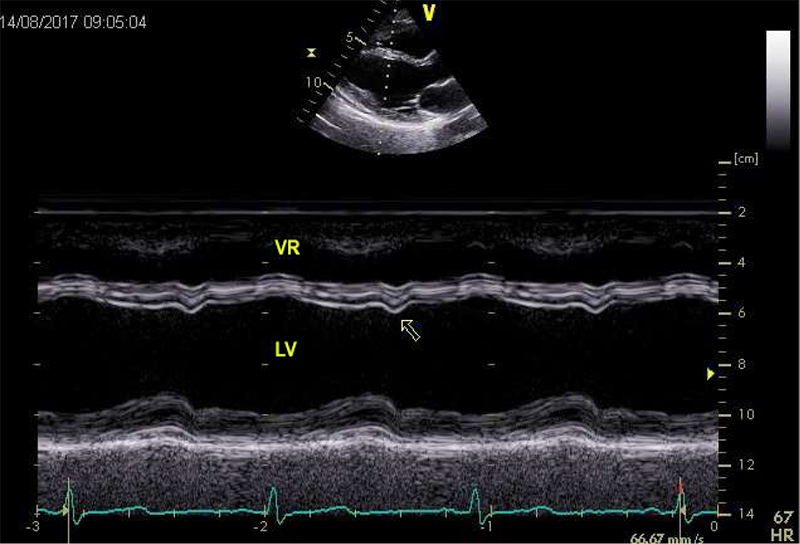Volume 112, Nº 1, January 2019
DOI: http://www.dx.doi.org/10.5935/abc.20180220
ORIGINAL ARTICLE
Left Ventricular Regional Wall Motion Abnormality is a Strong Predictor of Cardiotoxicity in Breast Cancer Patients Undergoing Chemotherapy
Márcio Vinícius Lins de Barros
Ariane Vieira Scarlatelli Macedo
Sebastian Imre Sarvari
Monica Hermont Faleiros
Patricia Tavares Felipe
Jose Luiz Padilha Silva
Thor Edvardsen

Figure 1 – Two-dimensional echocardiography–guided M-mode showing abnormal motion of interventricular septum (arrow) during chemotherapy treatment. LV: left ventricle; RV: right ventricle.
Abstract
Background: Chemotherapeutic agents of anthracyclines class and humanized monoclonal antibodies are effective treatments for breast cancer, however, they present a potential risk of cardiotoxicity. Several predictors have been recognized as predictors in the development of cardiac toxicity, and the evaluation of left ventricular segmental wall motion abnormalities (LVSWMA) has not been studied.
Objective: To analyze prospectively the role of LVSWMA among echocardiographic parameters in the prediction of development of cardiotoxicity in breast cancer patients undergoing treatment with chemotherapy.
Methods: Prospective cohort of patients diagnosed with breast cancer and in chemotherapy treatment with potential cardiotoxicity medications including doxorubicin and trastuzumab. Transthoracic echocardiograms including speckle tracking strain echocardiography were performed at standard times before, during and after the treatment to assess the presence (or lack thereof) of cardiotoxicity. Cardiotoxicity was defined by a 10% decrease in the left ventricular ejection fraction, on at least one echocardiogram. Multivariate logistic regression models were used to verify the predictors related to the occurrence of cardiotoxicity over time.
Results: Of the 112 patients selected (mean age 51,3 ± 12,9 years), 18 participants (16.1%) had cardiotoxicity. In the multivariate analysis using the logistic regression model, those with LVWMA (OR = 6.25 [CI 95%: 1.03; 37.95], p < 0,05), LV systolic dimension (1.34 [CI 95%: 1.01; 1.79], p < 0,05) and global longitudinal strain by speckle tracking (1.48 [CI 95%: 1.02; 2.12], p < 0,05) were strongly associated with cardiotoxicity.
Conclusion: In the present study, we showed that LVWMA, in addition to global longitudinal strains, were strong predictors of cardiotoxicity and could be useful in the risk stratification of these patients. (Arq Bras Cardiol. 2019; 112(1):50-56)
Keywords: Ventricular Dysfunction, Left; Drug Therapy; Cardiotoxicity; Breast Neoplasms; Anthracyclines; Trastuzumab.















